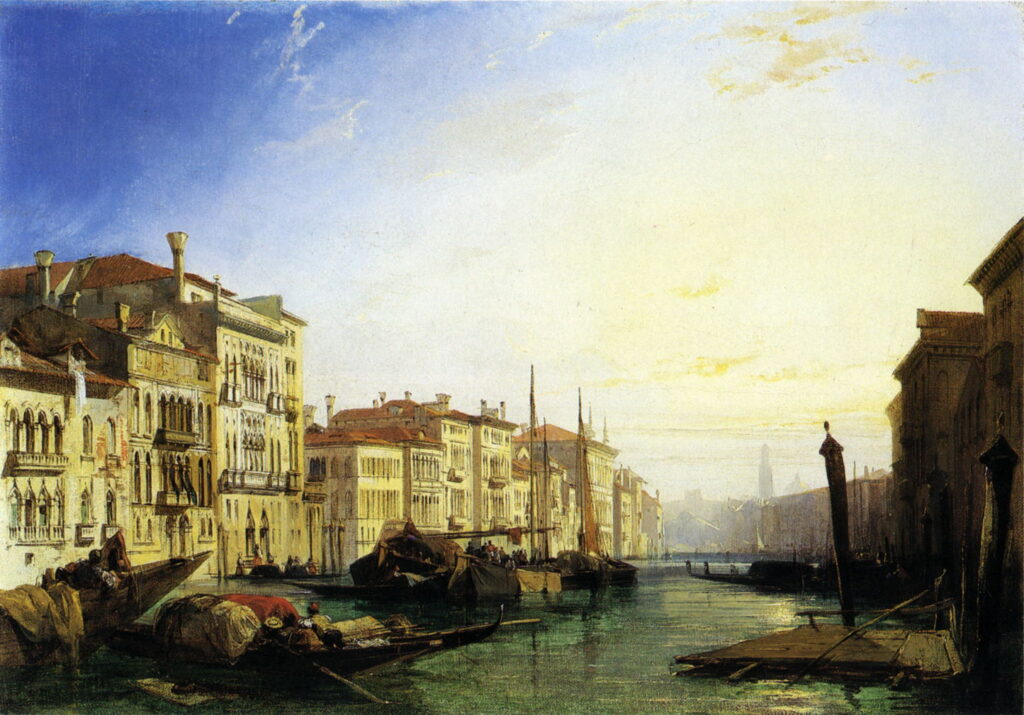Bonington’s brilliant decade of landscape paintings: 2

The first of these two articles on the short life of Richard Parkes Bonington (1802-1828) left him at the end of 1825, established as a successful painter of watercolour landscapes, many of which were turned into prints, and of acclaimed oil paintings.
Early in 1826, Eugène Delacroix invited Bonington to share his Paris studio. Although there doesn’t appear to be a detailed study of Bonington’s influence over Delacroix, perhaps the best summary is in Delacroix’s words:
“I never tired of watching his marvellous grasp of effects and the facility of his execution; not that he was readily satisfied. On the contrary, he frequently redid completely finished passages which had appeared wonderful to us; but his talent was such that he instantly recovered with his brush new effects as charming as the first.”
(Delacroix, Correspondence 4:287, letter of 30 November 1862, quoted in Noon p 41.)
Richard Parkes Bonington (1802-1828), Les Salinières near Trouville (1826) (144), watercolour over graphite, 11 x 21.5 cm, Getty Center, Los Angeles, CA. Wikimedia Commons.
Bonington continued to paint coastal views. Noon argues that his Les Salinières near Trouville (1826) was painted from memory in the autumn of 1826, recalling his tour with Huet the previous year, and after Bonington’s return from Italy to his own studio in Paris. The repoussoir trees at the left are wonderfully painterly.
Richard Parkes Bonington (1802–1828), The Abbey St-Amand, Rouen (c 1827-8) (147), watercolour, bodycolour, gum arabic, and washing out over graphite on medium, cream, slightly textured wove paper, 19.2 x 12.6 cm, Yale Center for British Art, New Haven, CT. Wikimedia Commons.
The Abbey St-Amand, Rouen (c 1827-8) is a rare late watercolour showing this dilapidated monastery near Rouen Cathedral. Noon suggests that Bonington may have painted it when he passed through Rouen on his way to London in 1827, or later from his memory and sketches.
From 1825, Bonington had also started painting in earnest figurative works of history painting. Although it would turn out that he had little time to develop in this genre, he demonstrated that he was as technically competent with figures as he was with nature.
Richard Parkes Bonington (1802–1828), Portia and Bassanio (c 1826) (340), watercolour and bodycolour over graphite, 16.5 x 12.7 cm, Yale Center for British Art, New Haven, CT. Wikimedia Commons.
Noon reveals that Portia and Bassanio (c 1826) shows a scene from Shakespeare’s Merchant of Venice (Act 3, scene 2), in which Bassanio has come to Portia’s palace at Belmont, to win her hand in marriage. To do this, he must choose the correct casket out of three containing gold, silver, and lead, of which the last contained the winning portrait of Portia. Here Portia’s maid Nerissa stands aside, and Bassanio, recognising his successful choice, seals the betrothal contract with a kiss.
Richard Parkes Bonington (1802–1828), The Use of Tears (1827) (380), watercolour, bodycolour, and gum arabic over graphite on thick smooth card, 23 x 18 cm, Yale Center for British Art, New Haven, CT. Wikimedia Commons.
The sentimental melancholy of The Use of Tears (1827) is tragically appropriate if not prescient. It shows a young woman in her sickbed, if not deathbed, a popular and commonly experienced scene at the time.
Richard Parkes Bonington (1802–1828), Knight and Page (Goetz von Berlichingen) (c 1826) (401), oil on canvas, 46.5 x 38 cm, Yale Center for British Art, New Haven, CT. Wikimedia Commons.
It was Noon who proposed that this painting, Knight and Page (Goetz von Berlichingen) (c 1826), showed Goetz von Berlichingen from Goethe’s Sturm and Drang tragedy of that name. He was a German warlord who struggled irrationally to defend his feudal lifestyle in the face of modern reform. Bonington probably painted this when he was sharing Delacroix’s studio in early 1826, and left it incomplete with Delacroix when he moved out.
In April 1826, Bonington left Paris with Charles Rivet and crossed the Alps via the Simplon Pass to Italy. After a few days rest in Milan, they pressed on to arrive in Venice later that month. Once there Bonington produced many sketches and studies, some watercolours painted in front of the motif, and a few oil sketches on millboard that were at least started en plein air.
Richard Parkes Bonington (1802–1828), On the Grand Canal (1826) (240), oil on millboard, 23.5 x 34.8 cm, Yale Center for British Art, New Haven, CT. Wikimedia Commons.
On the Grand Canal (1826) is a brilliant plein air oil sketch painted from a boat, showing the entrance to the Grand Canal. Bonington has removed one of the palazzi, but otherwise appears faithful to the motif.
Richard Parkes Bonington (1802–1828), The Grand Canal Looking Toward the Rialto (1826) (244), oil on millboard, 35.2 x 45.4 cm, Kimbell Art Museum, Fort Worth, TX. Wikimedia Commons.
The Grand Canal Looking Toward the Rialto (1826), also on millboard, may have been started en plein air, but appears to have been completed later in the studio, when back in Paris, which may account for the difference in hues in the sky.
Bonington and Rivet left Venice on 18 May, visited Padua, Florence, and Pisa, and Bonington then returned alone via Switzerland in June. Once back in Paris, he moved to his own studio, while remaining on good terms with Delacroix, who considered that the visit to Italy had changed Bonington’s style.
In the late Spring and early summer of 1827, Bonington went to London to develop his links with the art trade there. The later months of the year were extremely busy for him, preparing for a much-delayed Salon and other exhibitions. He was again highly successful at the Salon, eventually held in two parts during November 1827 and from February 1828, when Delacroix’s Death of Sardanapalus was first shown. Sadly Bonington’s paintings from the second part of the Salon have either vanished or become badly damaged, with a single exception.
Richard Parkes Bonington (1802–1828), Riva degli Schiavoni, from near S. Biagio (c 1827) (237), watercolour and bodycolour over graphite, 17.7 x 17 cm, Museum of Fine Arts, Boston, MA. Wikimedia Commons.
Riva degli Schiavoni, from near S. Biagio (c 1827) shows the San Marco basin from the Arsenal traghetto. Although a small watercolour, Noon considers it was painted well after Bonington’s return from Italy.
Richard Parkes Bonington (1802–1828), Ducal Palace with a Religious Procession (1827) (230), oil on canvas, 114 x 163 cm, The Tate Gallery, London (Presented by Frederick John Nettlefold 1947). Photographic Rights © Tate 2016, CC-BY-NC-ND 3.0 (Unported), http://www.tate.org.uk/art/artworks/bonington-venice-ducal-palace-with-a-religious-procession-n05789
Ducal Palace with a Religious Procession (1827) was apparently painted in late 1827 for James Carpenter, from graphite studies Bonington had made during his visit in 1826. Painted on a white ground, it unfortunately underwent severe shrinkage, and was extensively retouched as a result. However, it was generally very well received at the time, despite the liberties taken with its representation of the view.
Richard Parkes Bonington (1802–1828), The Piazzetta, Venice (1827) (231), oil on canvas, 44.2 x 36.7 cm, The Tate Gallery, London (Presented by Robert Vernon 1847). Photographic Rights © Tate 2016, CC-BY-NC-ND 3.0 (Unported), http://www.tate.org.uk/art/artworks/bonington-view-of-the-piazzetta-near-the-square-of-st-mark-venice-n00374
The Piazzetta, Venice (1827) shows the smaller Piazzetta passing out from the Piazza San Marco. This too was painted in the studio from graphite sketches made during his 1826 visit, and again takes liberties with reality.
In February 1828, Bonington visited London again in time to see the two views of Venice above exhibited at the British Institution, then returned to Paris to recuperate from the hectic work of the winter, resuming his printmaking projects. In May he sent three oil paintings for the Royal Academy exhibition, encompassing his coastal views, Venice, and history.
Richard Parkes Bonington (1802–1828), Grand Canal, the Rialto in the Distance – Sunrise (1828) (242), oil on canvas, 43 x 61 cm, Private collection. Wikimedia Commons.
Grand Canal, the Rialto in the Distance – Sunrise (1828) is another of Bonington’s finest oil paintings, made in the studio from graphite and other sketches from 1826. This painting has quite commonly been described as showing sunset, but as the view faces almost due east, must have been set in the early morning.
Bonington’s health was deteriorating during the early summer, and by the beginning of July he was physically incapacitated. He continued to sketch and paint from the back of cabs in Paris, but in September his parents had him moved to London for medical attention. He died there as a result of pulmonary tuberculosis – ‘King Death’ – on 23 September 1828, a month before he would have turned 26.
Richard Parkes Bonington (1802–1828), Corso Sant’Anastasia, Verona (1828) (221), oil on millboard set into panel, 60 x 44.2 cm, Yale Center for British Art, New Haven, CT. Wikimedia Commons.
Although painted on millboard suggesting that it may have at least started as a plein air sketch, his Corso Sant’Anastasia, Verona (1828) contains a lot of painterly detail that couldn’t have been completed in a single session. It’s also likely that the religious procession was a late addition, influenced by a Le Nain painting in the Louvre. Noon considers this was “almost certainly the last picture Bonington painted before his final illness in July 1828.”
Richard Parkes Bonington (1802–1828), Corso Sant’Anastasia, Verona (detail) (1828) (221), oil on millboard set into panel, 60 x 44.2 cm, Yale Center for British Art, New Haven, CT. Wikimedia Commons.
In less than a decade of painting professionally, Bonington was amazingly prolific: Noon’s catalogue includes 400 watercolours and oil paintings, and there are undoubtedly many others still unknown or lost. He had a direct influence on Delacroix, and thereby indirectly on the Impressionists and the major changes of the latter half of the nineteenth century. His use of colour and light, his painterly brushwork, his development of coastal landscapes in Normandy, and of riverbank scenes in the Île de Paris, were important groundwork for the Impressionists. Bonington’s scenes of the traditional fishing industry operating on beaches may even have influenced Eugène Boudin in his paintings on the Channel coast of France, and perhaps the much later watercolours of Winslow Homer at Cullercoats in England.
References
Biography by Bruce MacEvoy
Wikipedia’s short article
Noon P (2008) Richard Parkes Bonington, The Complete Paintings, Yale UP. ISBN 978 0 300 13421 6. Note that numbers given after the year of each painting in the captions refer to Noon’s catalogue.



